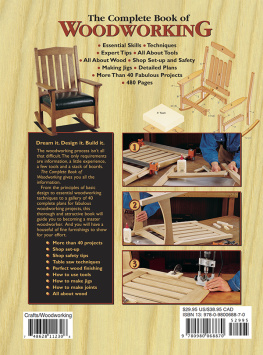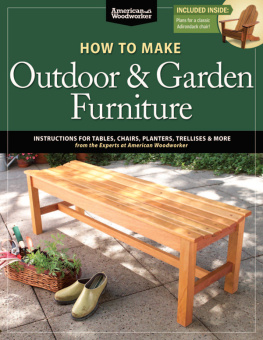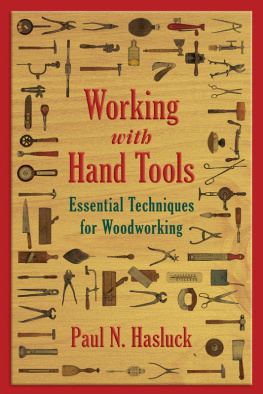First published in 2005 by The Crowood Press Ltd, Ramsbury, Marlborough, Wiltshire, SN8 2HR
www.crowood.com
This e-book edition first published in 2012
Anthony Hontoir
All rights reserved. This e-book is copyright material and must not be copied, reproduced, transferred, distributed, leased, licensed or publicly performed or used in any way except as specifically permitted in writing by the publishers, as allowed under the terms and conditions under which it was purchased or as strictly permitted by applicable copyright law. Any unauthorised distribution or use of this text may be a direct infringement of the authors and publishers rights, and those responsible may be liable in law accordingly.
ISBN 978 1 84797 441 9
For many people, the garden is an extension of their home, regardless of its size and whether or not it is made up of beautifully maintained lawns and lovingly nurtured flower borders, or is simply a small patch of ground with a patio. Indeed, those of us who live in town houses with no garden at all can still create an outdoor atmosphere by using window ledges and balconies with a little imagination.
The garden gives us all an opportunity to enjoy outdoor life through the entire year, starting with the freshness of spring when new growth is just beginning to stir and come to life; the warmth of summer with its long hours of daylight and the opportunity this affords to eat outside; the coming of autumn, when fruit trees bear their annual crop; followed by the short cold days of winter, when we gaze out upon leafless branches and empty borders, knowing that it is time to help our small feathered garden visitors through the difficult months by offering them shelter in the form of birdhouses with the chance to provide sustenance. Each season brings its own view of nature, and the garden is our private version of it.
Like the home, no garden is complete unless it is provided with the right sort of furniture to suit our particular taste. For no matter how big or small the garden happens to be, whether we prefer to look out upon a broad expanse of green lawn, the myriad colours and mingled fragrances of planted flowerbeds, or trees and hedgerows in full blossom, our enjoyment of these wonderful outdoor surroundings is made so much more pleasurable when the garden or terrace is furnished with tables, chairs and the many other accessories that help to make it complete.
This book concerns itself with the building of traditional garden furniture, those items that we would consider essential for our comfort and convenience, in a traditionally accepted appearance or design. None of these items is either expensive or complicated to make: indeed, the woodworking techniques have been simplified throughout, to ensure that the reader does not require a great deal of knowledge and experience of woodwork. Nor should it be assumed that the workbench needs to be equipped with a vast array of costly and complex tools in fact, rather to the contrary : the workbench for these projects does not need to be stocked with anything other than a set of basic, good quality woodworking tools. If you happen to be in possession of power tools and know how to use them safely and effectively, all well and good, but they are not a necessity to the achieving of first class results. There is always something particularly satisfying about producing a completed piece of woodwork entirely by hand, using a modest array of tools.
As for the readers own individual ability, the usual advice is that it is wisest to commence with the easier items and progress gradually to the more difficult. However, joints and techniques have been kept as straightforward as possible, so even the larger projects are well within the scope of the reasonably competent woodworker. For the novice, it might seem rather daunting to contemplate making the bench seat, which is the biggest piece of furniture in the book, especially since it involves large sections of wood which may be quite expensive to purchase. But if you practise first on cutting the required joints inevitably mortise and tenon joints in small sections of the same wood and follow the old axiom of measure twice and cut once, you will probably surprise yourself with the way you quickly progress.
Before describing in easy step-by-step instructions how each of the projects is made, the first chapters set out the basis of our approach to tools and materials, and the joints that are most commonly employed throughout the book. Each of the projects has a high degree of versatility, in that the design can be adapted or modified to suit the size of the garden for which it is intended, or to create an object that will serve a different purpose.
Where you have the greatest choice in any matter, is in the type of finish that is applied to the wood when the piece of furniture has been completed. These days there are so many different types of wood finish available that it is very hard to decide which is best, although to some extent the question is simplified by the fact that all of the items are intended for outdoor use, with one or two exceptions which could be considered more suitable for the conservatory, and therefore mostly you will need to opt for a water- resistant finish which will protect the wood from long periods of exposure to sun, wind and rain. It is then more a matter of determining the colour of the finish and judging the surface appearance of the wood after it has been applied and allowed to dry thoroughly: both of these being considerations of personal preference.
The best advice with regard to the treatment of the wood is to use offcuts and experiment with a variety of finishes until you obtain the result you find most satisfactory; and of course a more expensive product should give you better and longer-lasting protection.
No more need be said by way of introduction, other than to wish you the best of luck with your endeavours in the hope that the designs in the following pages will enhance your own garden, patio, terrace, conservatory or whatever provides you with your access to the outdoor world.
It is possible to make most of the items in this book without needing a fully equipped workshop, although the more facilities and tools that are available to you, the easier it will be to produce good quality results. With a little ingenuity, a handful of basic tools, and some space at one end of the kitchen table, there is no reason why the keen woodworker cannot make pieces of furniture to the highest standard of finish. On the other hand, this is not really the most satisfactory way of proceeding, for several reasons.
A proper working area is recommended, whether it is a spare room inside the house, part of the garage or a garden shed. Timber tends to be supplied in long lengths, and you require space in order to handle it safely and efficiently. A workbench of some sort is essential, whether it is a purpose-made wooden bench equipped with a vice, a fold-away version or merely a sturdy table to which you can clamp the material whilst you work on it. The area needs to be dry, with reasonable ventilation, and preferably supplied with electricity for the provision of adequate lighting and to power any special tools that you may happen to own.
The working area should also be kept clean. This is particularly important from a safety point of view. Accumulated off-cuts of wood, shavings and sawdust build up very quickly, and present a fire hazard. Waste material should be gathered up at the end of every session and placed in rubbish bags for disposal. Apart from anything else, an untidy workshop is more likely to encourage accidents, and safety should always be uppermost in your mind.
Even the most harmless-looking tools can be dangerous, if stored or handled incorrectly. Sharp chisels should always have their tips covered when not in use, and manipulated with the greatest of care; saws should be hung up in a special place when not needed; and power tools demand constant vigilance. You are most likely to own an electric drill, planer, jigsaw and possibly a router if you have any power tools at all, and each of these can do great damage in a fraction of a second.













